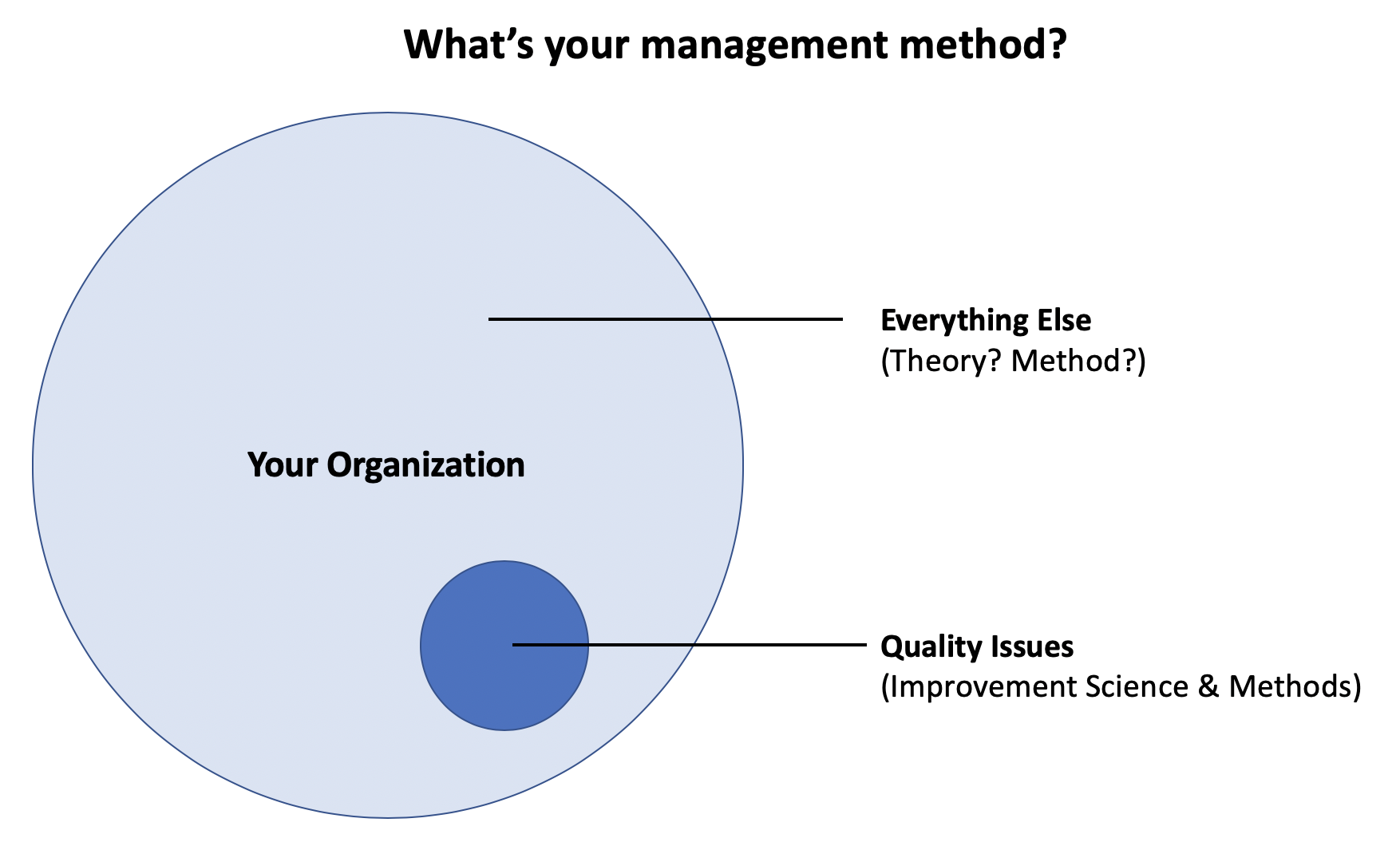What’s Your Management Method?
Source: James L Reinertsen, MD, The Reinertsen Group
Recently I sat down with Dr. Jim Reinersten to think about what makes traditional leaders shift to being quality leaders. Dr. Reinersten is a rheumatologist by training and former hospital chief executive. He’s also a Senior Fellow at the Institute for Healthcare Improvement and advises healthcare leaders on improving quality and patient safety. He is deeply grounded in the science of improvement and is an advocate for managing for quality.
I asked Dr. Reinersten: What causes leaders to shift to leading with quality as their leadership method? He shared this story with me and I want to share it with you.
When he talks to leaders, he draws a circle. This circle represents your organization. It includes all of the things that you do and all of the issues and problems that you have.
Inside this circle is a smaller circle. This is what you describe as your “quality problems.” What do you do when you have quality problems? Leaders are usually quick to answer. They describe having a dedicated quality department, led by a quality officer, and she has a team of trained improvement staff who are capable of bringing a set of tools and methods to understand the problem and fix it. Everyone nods in agreement and affirmation that this is true and present. Great! Makes sense, right?
Now Dr. Reinertson points to the rest of the circle. This area outside of the quality problems…What method do you use to manage the rest of the organization? What follows is fascinating. This is likely the first time anyone has asked them what their theory of management is. Some leaders pause and reflect, others look puzzled, and a few tell stories of specific things they managed, but rarely can the leaders clearly articulate a theory of management. Even rarer is a leadership team with a shared theory.
Sometimes a leader has a more cohesive answer. They’ll describe setting specific objectives for the organization to pursue each year. These are communicated across the organization and staff (we always hire the best) will be given accountability to work hard to meet them. Hard work is an assumed part of the equation. Go a little deeper and they may add the organization’s approach of aligning employee incentives (bonuses and pay raises) to these targets to help motivate them. Generally, this is some version of management by objective.
Management by Objective was formulated as a management practice in Peter Drucker’s 1954 book The Practice of Management and includes five components:
- Look at the organizational goals
- Set specific objectives for workers aligned to the goals
- Monitor progress toward the goal
- Evaluate employee work to their goals
- Reward individual performance
Drucker theorized this helped workers to be aligned with the goals of the organization and, together with their manager, the staff creates clear objectives for their personal contribution in their role to meet those goals and the agreed standards of evaluation. This may be supplemented with other management practices like open-door policies and management by walking around intended to make managers more accessible to help staff meet the objectives.
Does this sound familiar? You may even be experiencing this right now in your work. While more specific and coherent, it suffers from a key flaw. This management thinking lacks appreciation for the system the staff must work in to meet the objectives. Has leadership built an organizational system that knows what work needs to be done for the customer? Do we know what is the best way to do it? Do we use scientific problem solving to learn and continually improve? It’s nearly impossible for even the best employee to produce quality, efficiently, and continuously when the system is not built to support them doing their best work for the customer.
Leading for quality is a management method that supports continuous improvement for those you serve. It’s not one of your methods or a method for quality problems, it is your theory for how to design, lead, and improve an organizational system to meet the needs of your customer and create an engaging and satisfying work community worthy of being part of. Adopting quality as your strategy improves quality, reduces cost, and creates a great experience for all. To learn more start here.
—
If this was helpful, share and include me @DaveWilliamsATX. Subscribe to receive a monthly curated email from me that includes my blog posts and Improvement Science resources I think you’d appreciate.
